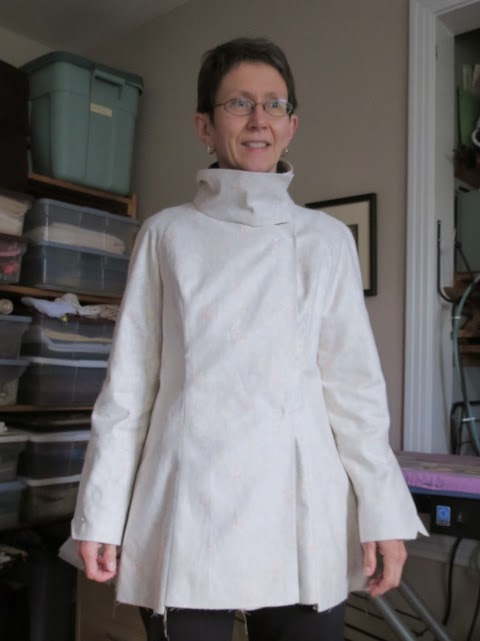 |
| Wonderfully thick border embroidery, hi-lo hem |
 Deepika told me she had found the fabric at a Fabricville store (Canadian chain found in Quebec and maritime provinces, of unknown connection with Fabricland which is found in Ontario and other Canadian provinces) and that she had some leftovers which (with very little pressure on my part) she offered to me. It arrived in the mail a few days later.
Deepika told me she had found the fabric at a Fabricville store (Canadian chain found in Quebec and maritime provinces, of unknown connection with Fabricland which is found in Ontario and other Canadian provinces) and that she had some leftovers which (with very little pressure on my part) she offered to me. It arrived in the mail a few days later.So with the shameless objective of slavishly copying Deepika's perfect solution for this fabric, I bought the Named Clothing pattern for the Inari Tee dress. Named Clothing is an indie pattern company based in Finland that's new to me. I had seen very positive reviews of the Inari dress on blogs and PR. But until I saw Deepika's version it hadn't clicked that I needed it.
What can I tell you about Inari? It's always helpful to have access to the experience of others which allows you to make needed or potentially needed adjustments before cutting into your precious fabric.
From my reading, I had learned that the pattern combined a low/deep armscye with a fitted (narrow) sleeve and high sleeve cap. Such a sleeve creates a tube that is pretty much fixed at a fairly steep angle (graphically explained at Lorenzo's Workshop). The garment looks trim, tailored and fantastic until you try to raise your arms beyond the point at which the angle of your arms can be accommodated within the angle of the sleeve tube. Beyond that point you get bunching at the shoulder and the body of the garment is pulled up, as your body movement forces the garment to move in ways it's not engineered to accommodate.
The quick and very easy fix for this is to flatten the sleeve cap. Carolyn explains it very well in this post and I just did what she did. The only point I will add is that (unlike the pattern piece in the photo on Carolyn's blog) the original sleeve in my size on the pattern has very strange, non-square corners at the underarm seam. This is contrary to all the normal rules of pattern drafting since, once the seam was sewn, it would generate an unsightly and awkward point at the lower edge of the sleeve. While it would create more room in the sleeve (at the hem) it would put that room in a place (under the arm) where it is completely unhelpful! It would also make it hard to attach the separate cuff piece, which is exactly rectangular.
All of which to say that when I added the wedge to flatten the sleeve cap, I also fixed this problem by squaring the underarm seam (see photo). The result was to move the extra hem width from underarm to under the sleeve cap, keeping the sleeve hem dimension matching the original cuff piece but in a flatter capped sleeve. This is a totally invisible but very functional alteration.
I also dithered about length. The picture on the Named Clothing website is of a dress that is very much above the knee. Carolyn's dress is also very short on her. Deepika's dress is knee length (but I am taller than her). The pattern says it is designed for a person who is pretty tall at 172cm (5'-8") - I'm 2 inches shorter. I liked the knee length look. I non-scientifically decided to add 3cm to the pattern, and the fact that the border would not be hemmed means that my dress is probably a total of about 6cm longer than the original pattern. It turned out the perfect length so ... phew!
To continue the saga, I failed to read the instructions through (bad bad Sewing Lawyer!) and so did not notice that the pattern pieces incorporate a 1cm seam allowance until after I had cut it all out. I had assumed, fresh from my experience of sewing the also-European Audrey dress, that I'd have to add allowances. Luckily I realized this before I sewed it all up, and it is always feasible to cut off the unnecessary allowance! However I kept the extra at the side seams both for fitting insurance and to make these seams more substantial, which helped at the hem slit, since it's finished by just turning back the seam allowances which at 1cm would be a pretty skimpy finish.
The finished dress is just lovely - the weight of the embroidery gives it a bit of presence and it's super easy to throw on but looks great (in my opinion anyway). I think I'll wear it to my cousin's wedding this weekend.
The finished dress is just lovely - the weight of the embroidery gives it a bit of presence and it's super easy to throw on but looks great (in my opinion anyway). I think I'll wear it to my cousin's wedding this weekend.


0 Comments